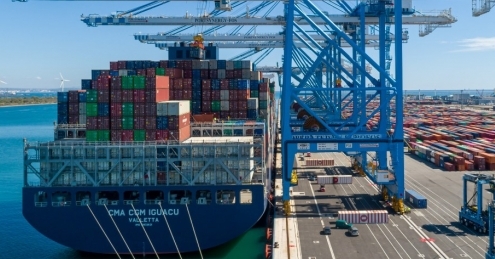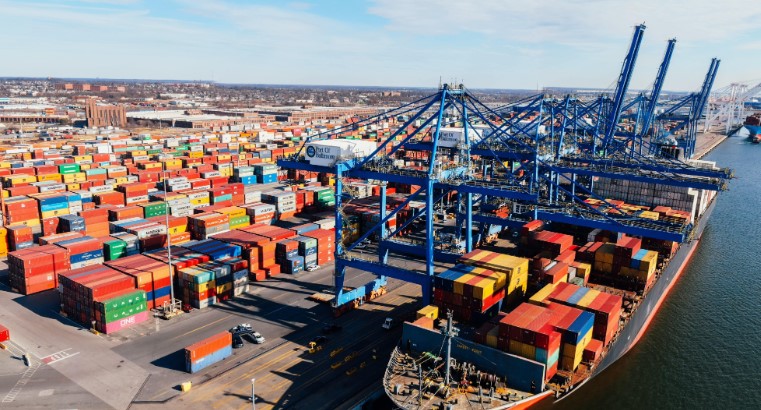
The Revolution of port sector dominated by private enterprise
- जुलाई 14, 2023
- 0
In the central budget documents of 1996-97, it was said, “The big problem with ports is that they are unable to balance their existing capacity with the demand for traffic.”
According to the situation on March 31, 1997, major ports (which were all under government ownership at that time) handled 22.7 crore tonnes of cargo, compared to a total capacity of 21.7 crore tonnes. The time taken to load and unload cargo in port was not acceptable due to delays in vessel arrival and departure caused by the time taken to prepare vessels for the return journey. Shipping lines that operated vessels complained of sluggish and inefficient operation, while importers and exporters expressed their anger over the excessive time taken for clearing.
However, if we turn towards 2021, we see a significant change. In 1999, the total traffic at all Indian ports was 33.4 crore tons per year, with private ports accounting for 7.4% of the share. By 2021, the traffic at all ports had increased to 125 crore tons per year (approximately four times the increase), and the share of private ports and terminals (including domestic facilities) had dramatically increased to 73.2%.
In the 1990s, the average time it took for a ship to return (ASTA) was about 7.8 days. By 2021, this figure had decreased to 2.2 days (in some specific ports, such as cargo containers, this figure has decreased to 19 hours). There have also been improvements in other operational efficiency indicators, such as cranes per hour and demurrage fees.
This journey in India’s basic framework can be called the “Silent Revolution”. It is estimated that private investment in ports and port-related road and rail connectivity is around 1.6 lakh crore rupees, and it has exceeded private investment in airports in the last two decades. Public investment in ports is not visible, and therefore this fact is often not publicized.
The change in the Indian port sector is clearly due to a single factor, which is that this sector is being opened up for private investment and private enterprises. The period from 1999 to 2023 demonstrates the participation of the private sector (domestic and foreign) in port development and operation.
Ports today represent a thriving infrastructure sector where competition brought by private enterprises has significantly improved the management of the entire area.
Indian ports are being praised in the shipping and logistics sector for demonstrating better policies in unloading and loading cargo from ships, particularly handling large vessels such as Panamax and Capesize with ease. This indicates that private capital and enterprises can achieve great success if treated with impartiality, as demonstrated by India’s private ports.
निजी उद्यमों के बलबूते बंदरगाह क्षेत्र में क्रांति
वर्ष 1996-97 के केंद्रीय बजट दस्तावेज में कहा गया था, ‘बंदरगाहों के साथ एक बड़ी समस्या यह है कि ये अपनी मौजूदा क्षमता और यातायात की मांग के बीच कोई तालमेल नहीं बना पा रहे हैं।’
31 मार्च, 1997 की स्थिति के अनुसार 21.7 करोड़ टन की कुल क्षमता की तुलना में प्रमुख बंदरगाहों (उन दिनों व्यावहारिक रूप से सभी सरकारी स्वामित्व के अधीन थे) ने 22.7 करोड़ टन का संचालन किया। जहाज के बंदरगाह में प्रवेश करने में देरी के साथ ही माल को लादने उतारने के साथ ही वापसी यात्रा के लिए जहाज को तैयार करने में लगने वाला समय भी स्वीकार योग्य नहीं था। इसके अलावा जहाजों का संचालन करने वाली कंपनियों (शिपिंग लाइन) ने लगातार सुस्त और अक्षम संचालन के बारे में शिकायत की जबकि आयातकों (importers) और निर्यातकों (exporters) ने क्लियरिंग में अनुचित रूप से लंबा समय लगने पर अपना रोष जताया।
लेकिन, अब अगर 2021 की ओर मुड़ें तो हमें बड़ा बदलाव दिखता है। 1999 में भारत के सभी बंदरगाहों पर कुल यातायात 33.4 करोड़ टन प्रति वर्ष था जिसमें निजी बंदरगाहों की हिस्सेदारी 7.4 प्रतिशत थी। वर्ष 2021 तक सभी बंदरगाहों पर यातायात 125 करोड़ टन प्रति वर्ष (लगभग चार गुना की वृद्धि) था और उल्लेखनीय बात यह है कि निजी बंदरगाहों और टर्मिनलों (घरेलू सुविधाओं सहित) की हिस्सेदारी नाटकीय रूप से बढ़कर 73.2 प्रतिशत हो गई।
1990 के दशक में जहाज की वापसी में लगने वाला औसत समय (ASTA) लगभग 7.8 दिन था। 2021 तक यह आंकड़ा कम होकर 2.2 दिनों तक रह गया (कुछ विशिष्ट बंदरगाहों में, कार्गो जैसे कंटेनरों में यह आंकड़ा कम होकर 19 घंटे तक हो गया है)। कई अन्य परिचालन दक्षता संकेतकों में भी सुधार नजर आया है जैसे कि प्रति घंटे चलने वाली क्रेन और विलंब शुल्क आदि।
इसे भारत के बुनियादी ढांचे की इस यात्रा में ‘मूक क्रांति’ कहा जा सकता है। यह अनुमान लगाया गया है कि बंदरगाहों और बंदरगाह से संबंधित सड़क और रेल कनेक्टिविटी में निजी निवेश लगभग 1.6 लाख करोड़ रुपये रहा है और यह पिछले दो दशकों में हवाईअड्डों में निजी निवेश से अधिक हो गया है। सार्वजनिक तौर पर बंदरगाह में निवेश नजर नहीं आता है और इसी कारण से इस तथ्य को अक्सर मान्यता नहीं मिल पाती है।
भारतीय बंदरगाह क्षेत्र में यह बदलाव स्पष्ट रूप से एक ही कारक के कारण हुआ है और वह है कि इस क्षेत्र को निजी पूंजी और निजी उद्यमों के लिए खोला जा रहा है। 1999-2023 की अवधि में बंदरगाह विकास और संचालन में निजी क्षेत्र (घरेलू और विदेशी) की भागीदारी को दर्शाती है।
बंदरगाह आज एक जीवंत बुनियादी ढांचा क्षेत्र का प्रतिनिधित्व करते हैं जहां निजी उद्यम द्वारा लाए गए प्रतिस्पर्धी दबावों ने पूरे क्षेत्र के संचालन में काफी सुधार किया है।
शिपिंग और लॉजिस्टिक्स क्षेत्र में भारतीय बंदरगाहों की प्रशंसा इस बात को लेकर हो रही है कि विकासशील अर्थव्यवस्थाओं के बीच इसने जहाजों पर से माल उतारने और लादने की बेहतर नीति का प्रदर्शन किया है और कुछ बड़े बंदरगाह बड़ी आसानी से विशाल पैनामैक्स और केपसाइज जहाजों को संभाल रहे हैं। यह इस बात का प्रतीक है कि निजी पूंजी और निजी उद्यमों के साथ निष्पक्षता बरती जाती है तो वे क्या कुछ नहीं हासिल कर सकते हैं जैसा कि भारत के निजी बंदरगाहों ने प्रदर्शित किया है।
































































